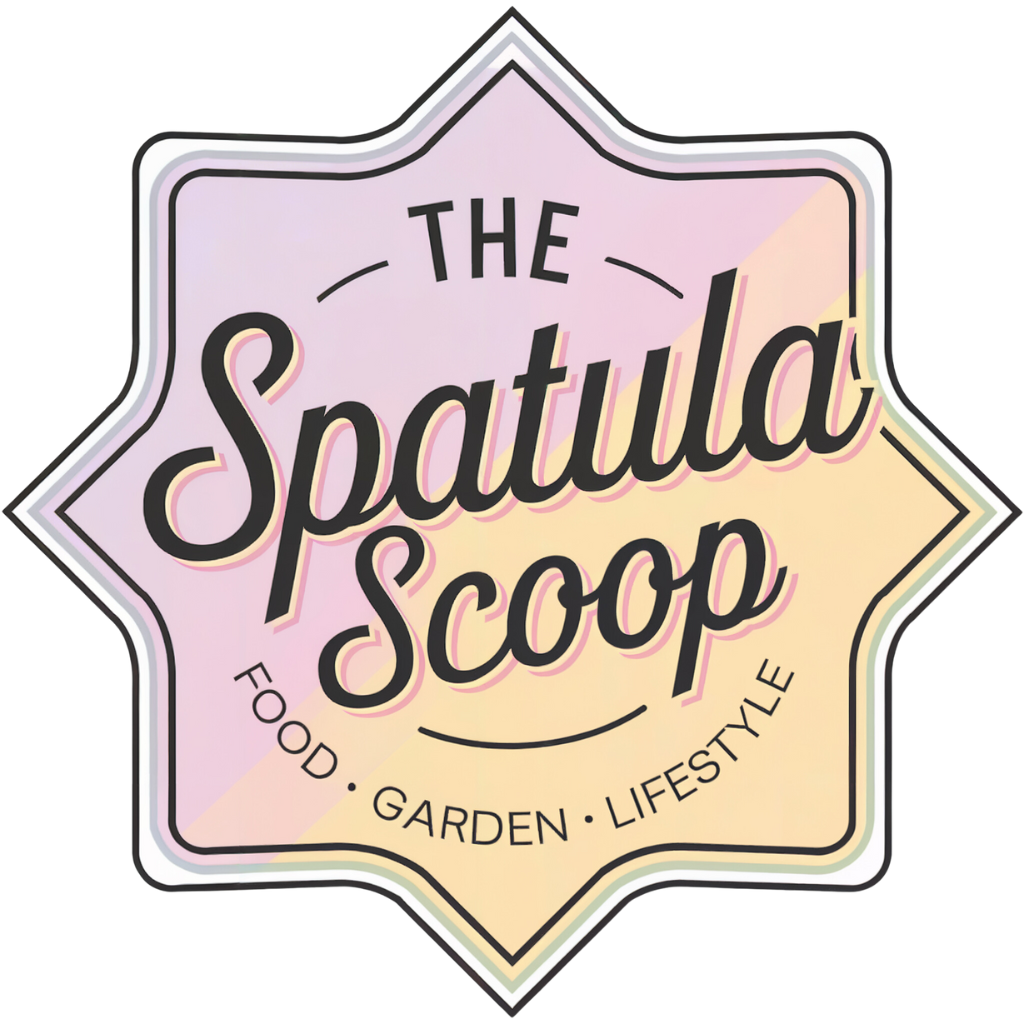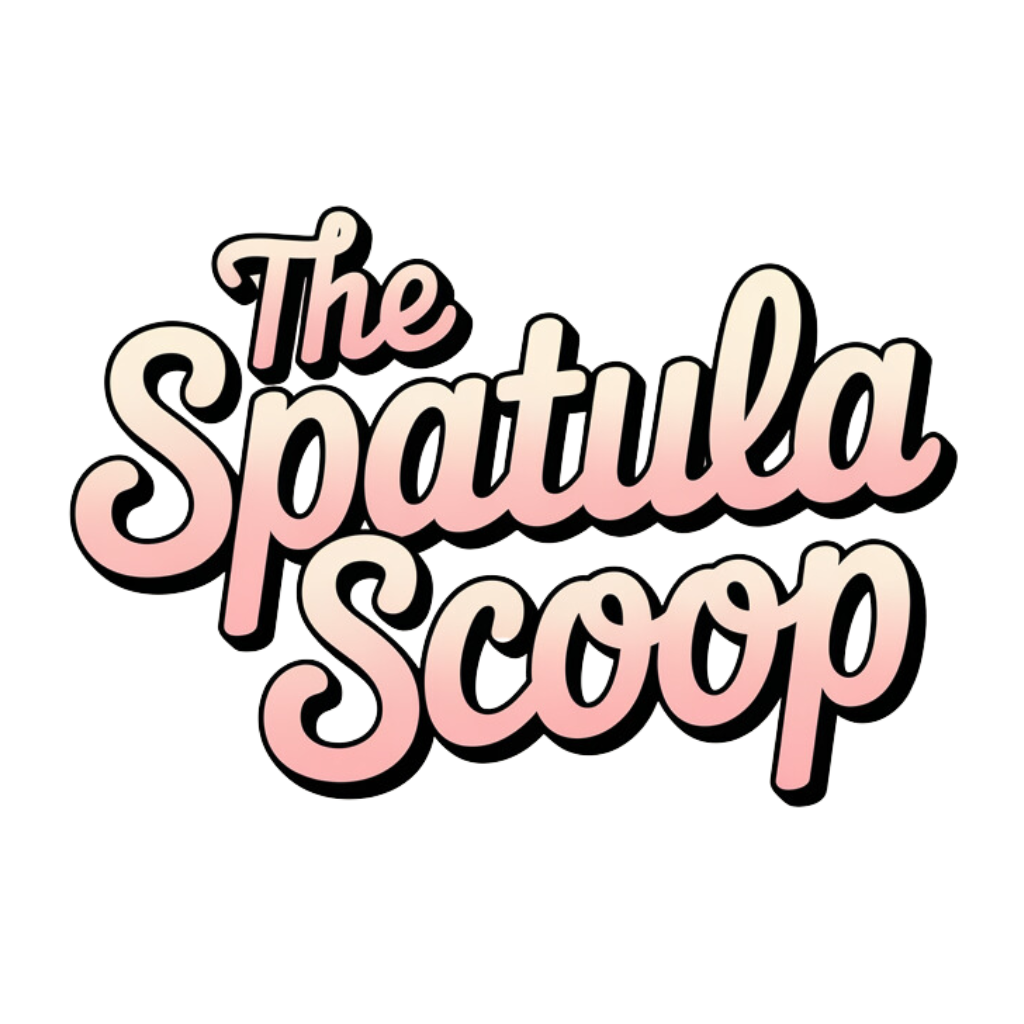What to Do With Leftover Beef Fat
Don't toss that leftover beef fat! You can render it into tallow, a versatile ingredient with numerous uses. To render, cut the fat into small pieces and melt it slowly in a cast iron skillet or slow cooker. Strain the liquid fat and store it in an airtight container. Use tallow for high-heat cooking, frying, or as a savory addition to baked goods. It's perfect for crispy potatoes or flavorful gravies. Beyond the kitchen, tallow can be used in skincare products, candles, and leather conditioning. Properly stored, it can last for months in the refrigerator or years in the freezer. There's a wealth of creative applications waiting to be explored with this often-overlooked ingredient.
This post may contain affiliate links. If you make a purchase through these links, I may earn a commission at no additional cost to you. Additionally, portions of this post may be generated using artificial intelligence (AI) technology. While we strive for accuracy, please be aware that AI-generated content may not always be perfect and should be fact-checked when necessary.
The Spatula Scoops
- Render the beef fat into tallow for cooking, frying, or baking, utilizing its high smoke point and rich flavor.
- Create homemade skincare products like soaps, balms, or moisturizers using the rendered tallow.
- Use tallow to condition and waterproof leather goods, extending their lifespan and appearance.
- Craft long-burning, scented candles by incorporating rendered beef fat into the wax mixture.
- Store rendered tallow in the refrigerator or freezer for future culinary or non-culinary applications.
Benefits of Using Beef Fat
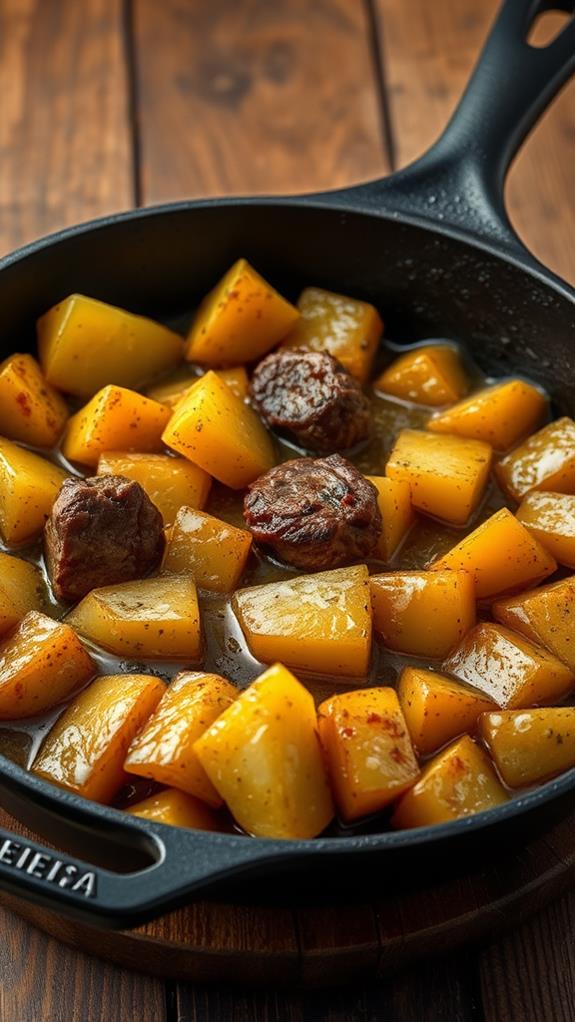
Many benefits come from using beef fat, or tallow, in your cooking and everyday life. When you render beef fat, you're creating a versatile ingredient that's both flavorful and stable at high temperatures. This makes rendered beef fat, or tallow, ideal for frying and roasting. To make beef tallow, simply heat the fat until it melts and strains out any impurities. For efficient preparation, you can use a stainless steel peeler to remove excess fat from beef cuts before rendering. This multipurpose tool can also help in preparing vegetables for dishes that complement your beef-based meals.
Tallow is rich in beneficial saturated fat, which contrary to popular belief, can be good for you when consumed in moderation. It's also a great source of omega-3 fatty acids, choline, and vitamin D. By incorporating rendered beef fat into your dishes, you'll enhance their flavor profile with a savory depth that's hard to replicate.
Using tallow is also an environmentally conscious choice. By utilizing the whole animal, you're reducing food waste and making the most of available resources. Beyond cooking, rendered beef fat has numerous applications. You can use it in skincare products, candle making, and even leather conditioning. This versatility makes tallow a valuable ingredient to keep in your pantry.
Rendering Tallow at Home
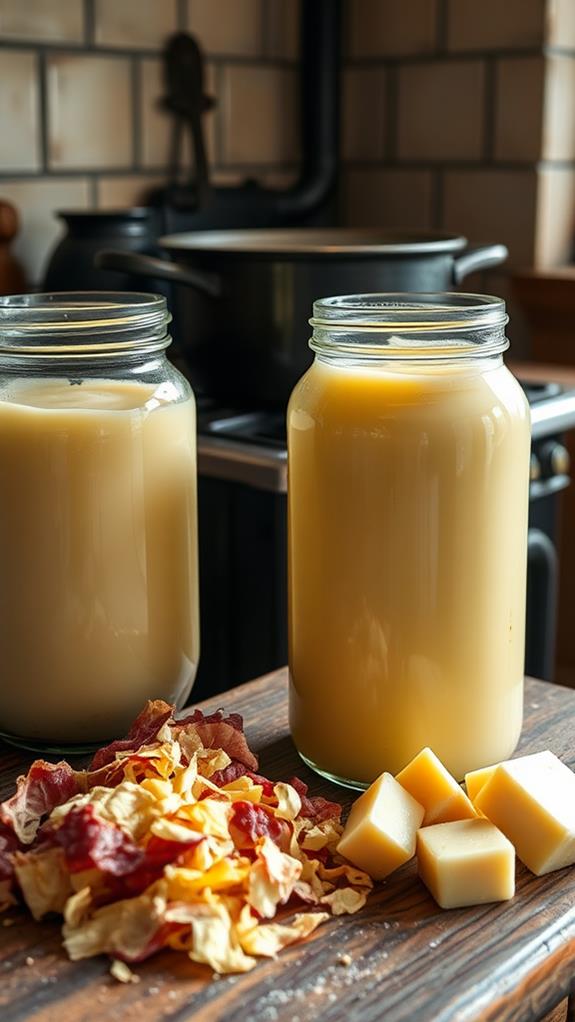
Now that you understand the benefits of beef fat, you might be wondering how to render tallow at home. The process is simple and can be done with leftover beef fat from your kitchen. To make tallow, start by cutting the fat into small pieces. Place these in a slow cooker or on the stovetop over low heat. The key is to cook the fat slowly, allowing it to melt and separate from any remaining tissue. For ideal results, consider using a cast iron skillet which retains heat effectively and guarantees even cooking.
As the fat renders, you'll notice it turning into a clear liquid. This is your tallow. Once fully rendered, strain the liquid through a fine-mesh sieve to remove any solid bits. Let the tallow cool slightly before pouring it into a glass jar or container for storage. To prolong its shelf life, refrigerate the tallow for up to three months or freeze it for up to two years.
The resulting tallow has a high smoke point of about 420°F, making it excellent for frying and high-heat cooking. You can use it in various recipes, from savory dishes to baked goods, maximizing the use of your leftover beef fat and reducing food waste.
Creative Culinary Uses
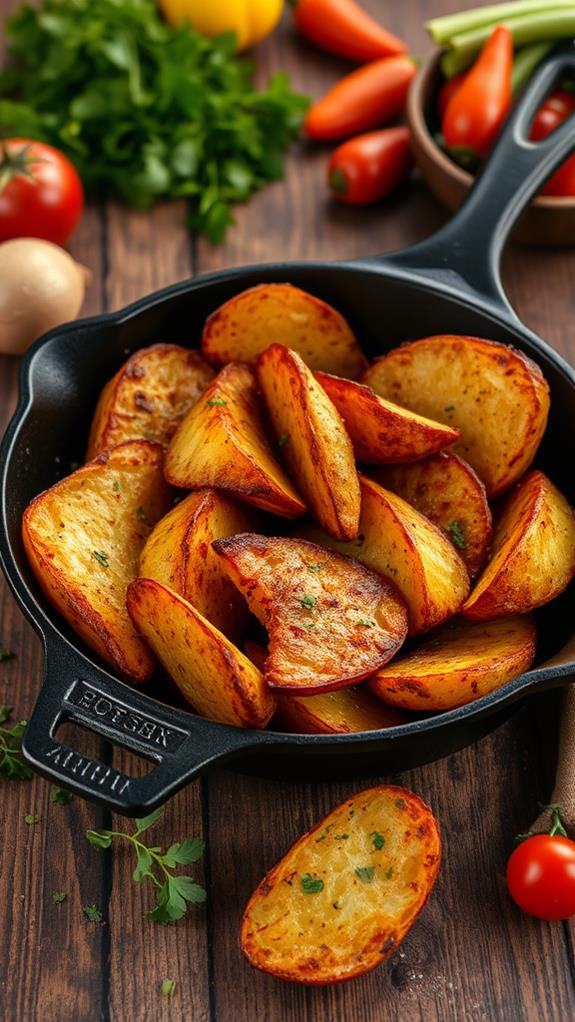
Tallow's versatility shines through in a variety of creative culinary applications. Once you've used a large stock pot to render the fat from beef trimmings, you'll have a treasure trove of melted beef tallow that can be used in numerous ways. Store it in an airtight container and get ready to elevate your cooking.
You'll find that tallow is a great addition to many dishes. Try incorporating it into your baking; it can add a unique savory note to baked goods like pastries and cakes. For a crispy twist, use it to fry up some delicious skillet potatoes or french fries. The high smoke point of tallow makes it ideal for achieving that perfect crunch.
Here's a quick guide to some creative uses for beef tallow:
| Culinary Use | Method | Benefits |
|---|---|---|
| Gravies | Incorporate into roux | Rich, flavorful sauces |
| Frying | Use for deep-frying | Crispy texture, high smoke point |
| Baking | Substitute for butter | Unique savory notes |
Don't limit yourself to just cooking. Tallow can also be used in skin products, adding another dimension to its versatility.
Storing Beef Fat Properly
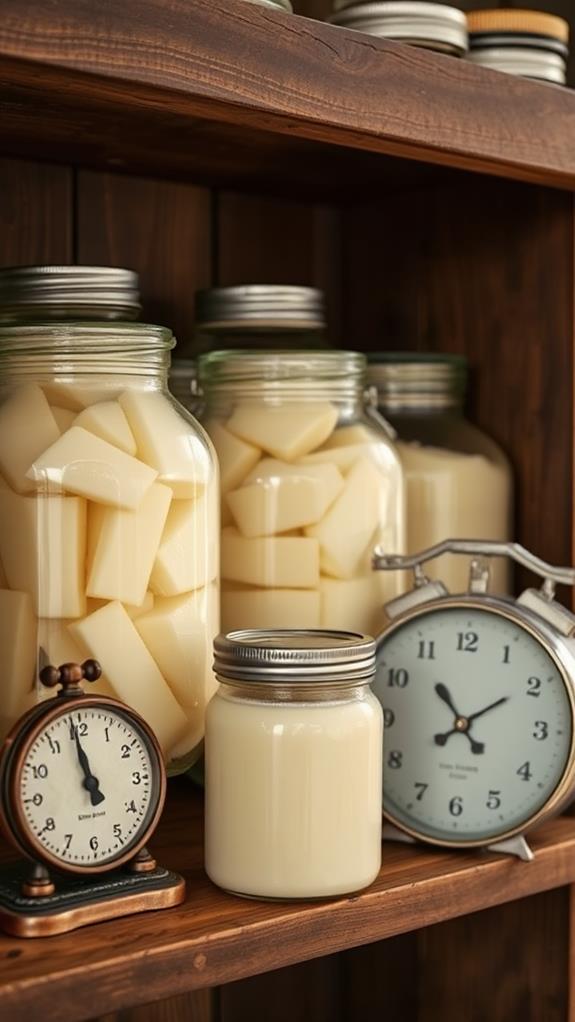
After rendering your beef fat into tallow, proper storage is essential to maintain its quality and extend its shelf life. Once you've completed the simple process of rendering fat in a dutch oven or large pot, it's crucial to allow the fat to cool slightly before straining. Use a fine-mesh strainer to remove any impurities or food particles, which will help preserve the rendered fat for longer. Similar to baking with silicone mats, using proper tools and techniques can greatly improve your cooking results and reduce waste in the kitchen.
For storage, choose an airtight container, preferably a glass jar with a tight-fitting lid. This will prevent odor absorption and keep the fat fresh. Avoid storing beef fat at room temperature, as it can quickly become rancid. Instead, place it in the refrigerator, where it can last up to 3 months. For even longer storage, you can freeze the fat for 1-3 years.
To maximize shelf life, divide your rendered fat into smaller portions. This way, you'll only need to thaw what you need, reducing exposure to air and potential contamination. Remember, while properly stored beef fat can last a long time, it's best to use it within a few months for peak quality and flavor.
Non-Culinary Applications for Tallow

Resourceful homesteaders and eco-conscious consumers have long recognized the versatility of beef tallow beyond the kitchen. When you render fat to make tallow, you're creating a versatile product with numerous non-culinary applications. To ponder, carefully pour the melted fat into a large container, leaving behind any impurities. Once cooled and solidified, your tallow is ready for use.
Unlike vegetable oils, tallow gives your homemade candles a longer burn time and pleasant scent. It's also an excellent ingredient for crafting moisturizing soaps and healing balms. Tallow's unique properties make it ideal for conditioning leather goods, helping to preserve and soften them over time. You can even use it as a natural lubricant for tools and machinery, as its high melting point resists heat and wear.
Make sure to reflect on tallow's waterproofing capabilities. It's effective for treating fabrics, wood, and other materials to improve their weather resistance. Historically, tallow has also been used in the production of explosives due to its stable chemical composition. By exploring these diverse applications, you're making the most of this valuable byproduct and reducing waste in your household.
Frequently Asked Questions
What Should I Do With Leftover Beef Fat?
Don't let your leftover beef fat go to waste! You can render it into tallow, a versatile cooking fat that's worth its weight in gold. Simply melt the fat in an air fryer or on the stovetop, strain it, and voilà! You've got a flavorful, high-smoke-point fat perfect for frying potatoes or other foods. It'll keep in the fridge for months or indefinitely in the freezer. Plus, you'll reduce food waste and get bonus beef cracklins as a tasty snack.
What Is Excess Beef Fat Used For?
You can put excess beef fat to good use in various ways. You'll find it's perfect for rendering into tallow, a versatile fat with a high smoke point. Use it for cooking, frying, or baking to add rich flavor. It's great for preserving leather, making candles, and crafting soaps. You can even use it in skincare products. By utilizing beef fat, you're reducing waste and embracing sustainability. Don't let it go to waste – there are plenty of practical applications for this valuable byproduct.
What Can I Do With Leftover Beef Grease?
Like liquid gold, leftover beef grease can be a valuable kitchen resource. You can render it into tallow, a versatile cooking fat with a high smoke point. Use it for frying, roasting, or baking to add rich, meaty flavor. Store rendered tallow in the fridge or freezer for months. Beyond cooking, you can use it to condition leather, moisturize skin, or make candles and soaps. Don't forget the tasty cracklins—season them for a savory snack or add to dishes for extra texture.
Can You Reuse Beef Fat?
Yes, you can definitely reuse beef fat. It's a versatile ingredient that shouldn't go to waste. You can render it into tallow, which has numerous uses. In the kitchen, you'll find tallow great for high-heat cooking, frying, and roasting. It adds a rich, savory flavor to your dishes. Beyond cooking, you can use tallow for making candles, soaps, or as a leather conditioner. By rendering and storing it properly, you'll have a useful product that lasts for months.
